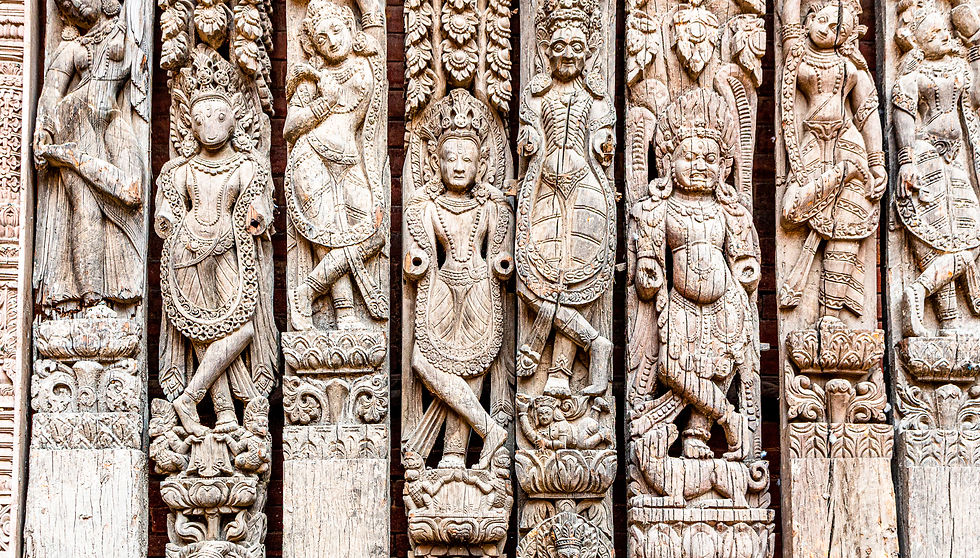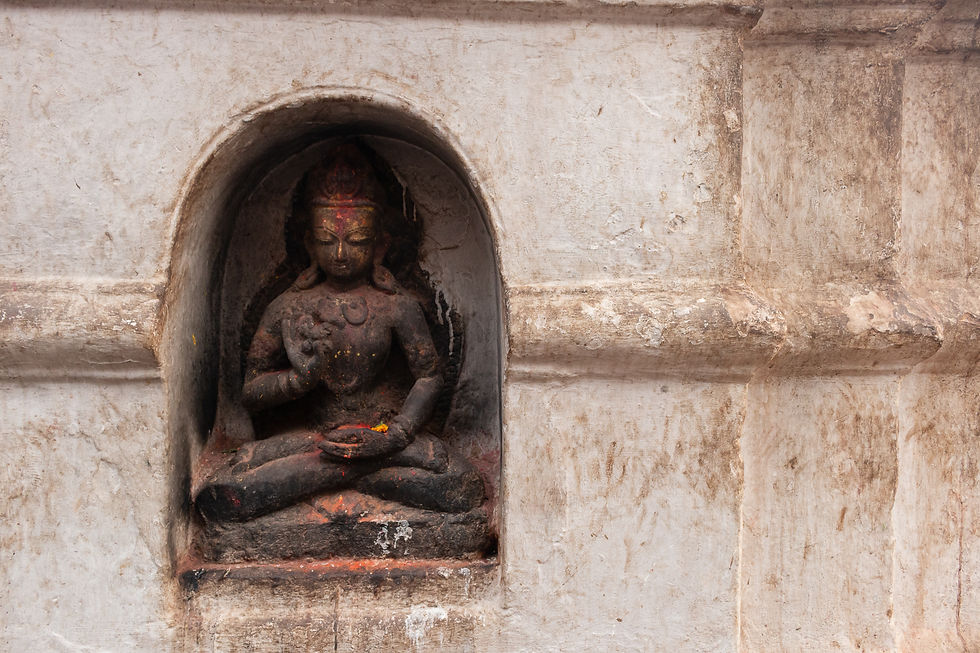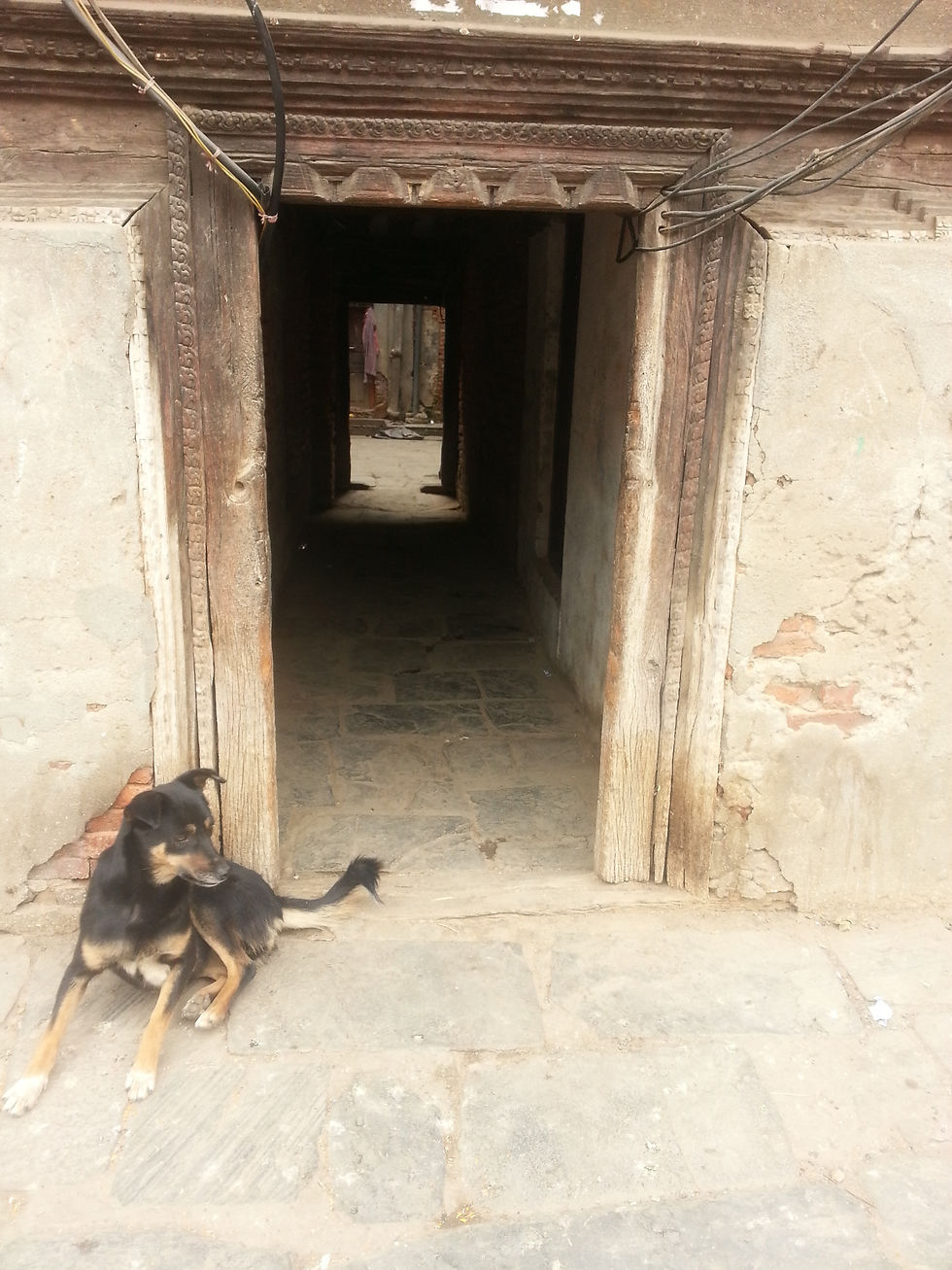Nuts and Bolts: Travel Tips for Visiting Kathmandu
- Rand Blimes

- May 15
- 10 min read

Nuts and Bolts posts give you the practical information you need, but without stripping away the humor, mishaps, and little victories that make real travel what it is. These aren’t just guides. They’re how we actually did it—mistakes, triumphs, and all.
This page has some travel tips for visiting Kathmandu, to aid in planning your own trip. Remember, we are a family of five, and we travel mostly to eat. We were in Kathmandu in April, 2016. If your trip to Kathmandu is significantly longer/shorter/with a different focus, you may have a very different experience.
My Love Affair with Kathmandu
When people find out that I travel as much as possible, they always ask the same question.
“What is your favorite place you have been?”
I hate this question. How am I supposed to answer? It's like asking me for my favorite child, or my favorite line from “Bohemian Rhapsody,” or my favorite lung.
No. I am not answering that question. Because there is no answer. But if there were an answer, it might be Nepal.
If you are really impertinent and ask my favorite place in Nepal, then (after giving you my best I’m-not-mad-just-disappointed look) I would probably say Kathmandu. Or Bhaktapur. Or the Chukhung Valley.
But maybe Kathmandu. And that is something.
Kathmandu has all the color and chaos that make India’s great cities amazing . . . but you can also get a steak . . . or even sweet and sour pork!
So don’t treat Kathmandu like a pit stop on your way to the mountains. The city is a very worthy destination in its own right.
Here are a few of our travel tips for visiting Kathmandu.

Travel Tips for Visiting Kathmandu: Weather
April is a pretty great time to be in Kathmandu—if you like sunshine, mild heat, a bit of dust in your teeth, and the occasional existential moment brought on by smog-filtered sunsets.
Daytime temperatures usually hover in the pleasant 75–85°F (24–29°C) range, which means T-shirts during the day and maybe a light jacket in the evenings.
Nights can be cooler—especially if you're staying in an older building that doesn't believe in insulation or hot showers on demand. Mornings tend to be crisp and hazy, like the city hasn't quite finished loading yet.
It’s the tail end of dry season, so rain is rare—but not impossible. More likely is a late-afternoon windstorm that kicks up just enough dust to make you look like you’ve been trekking, even if you just walked to a bakery.
One warning: air quality in April can be . . . let’s say ambitious. If you’re sensitive to pollution, bring a mask (not a metaphor). Locals seem to deal with it well enough, but if you own a pair of Western lungs, they may throw a little tantrum.

Bottom line? April is a sweet spot. Warm but not oppressive. Lively but not chaotic. A very good time to get lost in alleyways, chow down on momos, and watch the world whirl around you in a cloud of incense and occasional particulate matter.
Note that spring is probably the second best time to do most trekking. Your best bet for clear mountain weather is fall. In spring you may get enough haze to block those mountains views you are earning with your sweat and gasping breath. On the other hand, the rhododendrons will likely be in bloom.
Getting to Kathmandu
Kathmandu is the main international gateway into Nepal—and unless you’re trekking across a border on foot or arriving in style via paraglider (not recommended), you’ll probably be landing at Tribhuvan International Airport (KTM).
It’s not the most luxurious airport in the world—think more “functional chaos” than “architectural marvel”—but it gets the job done. Flights arrive regularly from hubs like Doha, Istanbul, Delhi, Bangkok, and Kuala Lumpur, and more airlines are adding routes each year. If you’re flying in from farther afield, you’ll likely connect somewhere in the Gulf or South Asia (or even, if you are like me, from Moscow).
Once you’re in the country, Kathmandu is the beating, honking, incense-scented heart of the road network. If you’re coming from Pokhara, you can take a tourist bus (6–8 hours, give or take road conditions and the driver’s relationship with mortality). There are also local buses if you want to save money or test your limits. Flights between Pokhara and Kathmandu are short and scenic (about 25 minutes in the air, and sometimes nearly as long on the tarmac).
From Royal Chitwan National Park, the tourist bus takes about 5–6 hours, with a few scenic bathroom breaks and the occasional cow delay. There are also buses and jeeps from places like Lumbini, Bandipur, and other less-touristed gems.
Heading to or from India? Kathmandu connects easily to the southern border. You can take a bus to Sunauli (the most popular crossing point near the town of Bhairahawa), or to other border points like Birgunj or Kakarbhitta, depending on where in India you're going. The borders are busy but manageable, especially if you’ve got your paperwork sorted and your expectations set to “slow but friendly.”
There are also frequent tourist busses that leave Kathmandu for Lhasa, Tibet. Make sure you check the current situation before you set out. Tour agencies in Kathmandu are perfectly happy to sell you a bus ticket to Lhasa knowing full well you will never make it through immigration and Chinese officials will turn you around and put you right back on a bus returning to Kathmandu.
In short: Kathmandu is where everything starts, ends, or passes through. And no matter how you get here, it’s always a bit of a ride.
Sleeping in Kathmandu for the Cheapskate Family
If Kathmandu had a neon-lit nervous system made of trekking poles, hemp pants, espresso machines, and incense smoke, it would be Thamel.
This is the city’s backpacker hub, travel planning headquarters, souvenir jungle, and carb-loading zone all rolled into one. If you’re looking for a cheap room, a mid-range boutique hotel, or a surprisingly good almond croissant, Thamel is a good place to look.
I don’t hate Thamel the way I do Khao San Road in Bangkok (seriously, will people please stop going to Khao San Road???!!!). I have spent plenty of time here on both my trips to Nepal. But I don’t tend to stay here. You get a great combination of soul and convenience if you stay outside of Thamel, but in fairly easy walking distance.
The first time I came to Kathmandu, I wanted to stay on Durbar Square. So I stayed in a little place right on the square, and I paid about $1US per night for my room there. Those days are long gone, and that hotel is no more.
The second time I went to Kathmandu, my family spent one night at the Kathmandu Resort Hotel in Thamel. It was fine, if a bit overpriced and soulless.
After one night, we moved out of Thamel to the wonderful Stupa Guest House. This place came with an incredibly friendly family that ran the place. Ram, especially, took great care of us. At the end of a week staying at the Stupa Guesthouse, Ram invited us to join his family for a home cooked dinner.
Oh, did I mention the place came with a friendly pouch named Jackie Chan that greeted us enthusiastically each time we returned for exploring the city?

Getting Around
Getting around Kathmandu is part of the adventure—or, depending on your mood, part of the test.
The city doesn’t have a metro system, and traffic rules operate more on vibes than enforcement. But there are options.
Walking is often the best way to explore the old parts of the city like Thamel, Asan, and Durbar Square. I strongly recommend staying at a hotel near these main parts of the city so you can just walk everywhere. Just be prepared to dodge motorbikes, potholes, and the occasional charging cow (seriously, one almost killed me the first time I visited the city). Sidewalks appear and disappear like shy animals, so stay alert and nimble.
Taxis are everywhere, though the meters are mostly decorative. Always agree on a price before you get in. Always. Short trips across town usually run 300–500 rupees, though your accent may add a little surcharge. No shame in negotiating with a smile.
Ride apps like Pathao and Tootle (Nepal’s versions of Uber and Grab) weren’t in use when we were there, but they are gaining ground. They may be cheaper than regular taxis and a good way to avoid price haggling—just know they sometimes struggle with GPS accuracy in Kathmandu’s warren of alleyways.
Microbuses and local buses are extremely cheap and extremely confusing. If you’re feeling adventurous, hop on one and see where you end up. If you're feeling tired, maybe don’t.
Peddle Rickshaws still ply the tourist-friendly routes between Thamel and Durbar Square. They’re fun, slow, and better for nostalgia than speed.
Kathmandu’s traffic can be chaotic, but it rarely moves fast enough to feel dangerous. Just breathe deeply (preferably through a mask), and remember that half the charm is in the unpredictability.
Where to Eat
Kathmandu is one of those cities where it’s very easy to eat well for very little money—or to eat really well for more money.
Let’s start with the basics: dal bhat. You’ll see it everywhere, and there’s a reason. It’s Nepal’s national fuel—rice, lentil soup, vegetables, pickles, and refills until you surrender. It’s filling, balanced, and surprisingly varied depending on the kitchen.
Momos are the next stop on the Kathmandu food tour. These little dumplings are filled with spiced vegetables, chicken, or buffalo (yes, buffalo—don’t knock it). You can get them steamed, fried, or “kothey” (pan-seared on one side, which is absolutely the correct answer). Order a plate and feel no shame when you order a second. Douse them with the green chili sauce in the bottles sitting on your table.
Kathmandu’s also full of international options—which may sound boring until you realize you’ve just spent two weeks eating garlic soup and boiled potatoes in the Himalayas. Suddenly that wood-fired pizza place or Japanese ramen shop becomes emotionally significant. Thamel, in particular, is a culinary wildcard: you can have Newari food one night and croissants the next. There is fantastically good Italian food. And beef and pork are there to be found.

What To Do
Kathmandu isn’t a checklist city—it’s a wander-and-see-what-happens kind of place. But if you’re wondering where to start, here’s a list of things worth doing, seeing, or accidentally stumbling into.
Explore Durbar Square
The old royal square is the historical and architectural heart of the city—and the spiritual one too, if you believe in the kind of spirituality that lives in carved windows, leaning temples, and pigeons that have seen it all. Yes, parts were damaged in the 2015 earthquake, but much remains—and what’s being rebuilt is done with care. And yes, you have to pay to enter now. It is a tricky debate, but I say it is worth it.
GO hang out with the temples and the pigeons. Don’t rush it. Let the stone speak.

See the Kumari
The Kumari is a living goddess—a real girl chosen to embody divine energy, who appears from a carved window for brief public glimpses. It's fascinating, complicated, and deeply rooted in tradition. If she looks at you, it's supposed to be good luck. Just don’t expect her to smile. Goddesses don’t perform on command.
Find the Courtyards
See that little door, maybe with carved wood around it, opening off some busy street? There is probably an unpromising, dingy passageway on the other side of it. You probably will have to stoop to pass through.
You want to go through that door. You want to shuffle down that passageway.
Because on the other side of doors like this all over the city are charming little courtyards.
You want to go explore those courtyards.

You see that sculpture sitting in the middle of the courtyard? It is a medieval work of art and in any other city in the world it would be in the national museum. In Kathmandu? Locals hang their laundry on it to dry. Kids use it like playground equipment.
Seriously, go through the door. Brace the narrow passageways. Find the courtyards.

Shop Till You Drop in Thamel
Thamel is a glorious mess of trekking shops, handicrafts, bookstores, knockoff North Face jackets, incense, and pashmina scarves you definitely don’t need. It’s overwhelming in the best way. Haggle politely, drink something cold when you’re tired, and don’t be surprised if you walk away with singing bowls you had no intention of buying.
Take Day Trips Around the Valley
Kathmandu is just one part of a valley filled with ancient cities, hilltop temples, and quiet villages. Bhaktapur, Patan, Panauti, Kirtipur, and the hill of Nagarkot are all easy day trips—and all feel like different versions of time travel. I’ll cover these more in a dedicated post, but consider this your friendly nudge to leave the city limits at least once.
Climb to Swayambhunath (a.k.a. the Monkey Temple)
Perched on a hill west of the city, Swayambhunath is one of the most iconic sights in Kathmandu. The climb up the 365 steps is a little sweaty, a little monkey-dodgy, and completely worth it.

A monkey tried to grab a water bottle out of my wife’s hand on the walk up. Instead of doing the smart thing and letting the primate with all the sharp teeth have her water, she shouted “NO!” in her best “mom voice.” And guess what . . . it worked! Still, you should probably not carry anything to temp the monkeys to thievery when you visit.
At the top of Swayambhunath: prayer flags, panoramic views, a stupa that watches you back, and bells that ring even when no one’s touching them.

Visit Kopan Monastery and Boudhanath
North of the city center, you’ll find two of Kathmandu’s most peaceful places. Kopan Monastery is a working Buddhist center where you can attend teachings, or just sit and breathe in the calm. Boudhanath, meanwhile, is one of the largest stupas in the world—a massive white dome encircled by prayer wheels, butter lamps, and pilgrims walking clockwise in a quiet, never-ending loop. Join them. It’s oddly soothing.
Kathmandu can be loud and dusty and beautiful and overwhelming—sometimes all in the same block. But give it a little time, and it starts to unfold. The chaos softens, the rhythm settles, and suddenly you’re making new friends in a hidden courtyard wondering how a place this old can still feel so alive. There’s no one right way to see the city. Just start walking. It’ll meet you where you are.




Comments